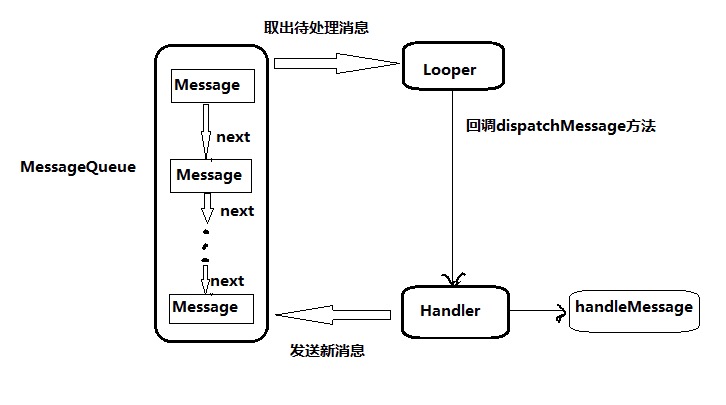Handler 对于 Android 开发来说简直就是家常便饭,它的原理自然都很熟悉,这篇文章不会宏观地去介绍它的原理,而是细节深入到各个组成。
关系
开始深入细节的时候,我们可以先复习下 Handler 、Looper 和 MessageQueue 三者的关系。
1. Handler 必须在 Looper.prepare() 之后才能创建使用
2. Looper 与当前线程关联,并且管理着一个 MessageQueue
3. Message 是实现 Parcelable 接口的类
4. 以一个线程为基准,他们的数量级关系是:
Handler(N) : Looper(1) : MessageQueue(1) : Thread(1)
他们的调用关系可以参考这张图:

分析
0x01
public Handler(Callback callback, boolean async) { // 代码省略 mLooper = Looper.myLooper(); if (mLooper == null) { throw new RuntimeException( "Can't create handler inside thread that has not called Looper.prepare()"); } mQueue = mLooper.mQueue; mCallback = callback; mAsynchronous = async; } |
从 Handler 默认的构造函数我们可以看到,Handler 内部会通过 Looper.myLooper() 来获取 Looper 对象,从而与之关联。
0x02
我们之前已经知道 Looper 管理着消息队列,从这里深入进去看看是如何跟 MessageQueue 建立联系。
public static @Nullable Looper myLooper() { return sThreadLocal.get(); } public static void prepare() { prepare(true); } private static void prepare(boolean quitAllowed) { if (sThreadLocal.get() != null) { throw new RuntimeException("Only one Looper may be created per thread"); } sThreadLocal.set(new Looper(quitAllowed)); } public static void prepareMainLooper() { prepare(false); synchronized (Looper.class) { if (sMainLooper != null) { throw new IllegalStateException("The main Looper has already been prepared."); } sMainLooper = myLooper(); } } |
在 Looper.myLooper() 里我们看到,Looper 是通过 sThreadLocal.get() 来获取,那么我们又是何时将 Looper 设置给 sThreadLocal 的呢?答案就在 prepare() 方法里。
我们看到 sThreadLocal.set(new Looper(quitAllowed)); 实例化了一个 Looper 对象给 sThreadLocal 并且一个线程只有一个 Looper 。
同时我也贴出了 prepareMainLooper() 方法,根据名字大家都可以猜到,这个方法就是在 Android 主线程(UI)线程调用的方法,而在这个方法里也调用了 prepare(false) 我们看到这里传入的是 false ,表明主线程这里的 Looper 是无法执行 quit() 方法。
我在这里贴出 ActivityThread 的 Main() 方法的部分代码,这也是我们程序的入口:
public static void main(String[] args) { // 代码省略 Looper.prepareMainLooper(); // 创建消息循环 Looper ActivityThread thread = new ActivityThread(); thread.attach(false); if (sMainThreadHandler == null) { sMainThreadHandler = thread.getHandler(); // UI 线程的 Handler } if (false) { Looper.myLooper().setMessageLogging(new LogPrinter(Log.DEBUG, "ActivityThread")); } Looper.loop(); // 执行消息循环 } |
在这里我们更清楚了为什么可以直接在主线程创建 Handler ,而不会发生异常。
以上,我们明白了 Looper 是通过 prepare() 方法与线程建立联系,同时不同线程是无法访问对方的消息队列。
为什么 Handler 要在主线程创建才能更新 UI 呢?
因为 Handler 要与主线程的消息队列关联上,这样 handleMessage() 才会执行在 UI 线程。
0x03
Looper 的核心其实是它循环取出消息的代码:
public static void loop() { final Looper me = myLooper(); if (me == null) { throw new RuntimeException("No Looper; Looper.prepare() wasn't called on this thread."); } final MessageQueue queue = me.mQueue; // 死循环 for (;;) { Message msg = queue.next(); // might block if (msg == null) { // No message indicates that the message queue is quitting. return; } /// Handler msg.target msg.target.dispatchMessage(msg); // 派发消息 // 代码省略 msg.recycleUnchecked(); } } |
从上面代码我们可以看到,Looper 在 loop() 方法里建立了一个死循环,通过消息队列里不断的取出消息,交给 Handler 去处理。
这个时候你可能会有一个问题:
Android 中为什么主线程不会因为 Looper.loop() 里的死循环卡死?
我比较推荐 Gityuan 的回答
回到我们这里,在循环中是通过 msg.target.dispatchMessage(msg); 派发消息。其中 msg 是 Message 类型,简单看看它的成员:
public final class Message implements Parcelable { Handler target; Runnable callback; Message next; public Object obj; public int arg1; public int arg2; // 代码省略 } |
可以知道消息队列是链表实现的,并且 target 是 Handler 类型。
现在就可以连通了,通过 Handler 将 Message 投递给消息队列(链表),Looper.loop() 循环从消息队列里取出消息,又将消息分发给 Handler 去处理。通过这个 target 我们也可以知道一个小细节,Handler 只能处理自己所发出的消息。
0x04
理解清楚之后我们跟着顺序,看看 Handler 是如何处理和分发消息的。
// 处理消息方法,交给子类复写 public void handleMessage(Message msg) { } public void dispatchMessage(Message msg) { if (msg.callback != null) { handleCallback(msg); } else { if (mCallback != null) { if (mCallback.handleMessage(msg)) { return; } } handleMessage(msg); } } private static void handleCallback(Message message) { message.callback.run(); } |
我们看到 dispatchMessage() 只是一个分发方法,如果 Runnable 类型的 callback 为空,则执行handleMessage(msg) 处理信息,该方法为空,是交给子类进行复写,并且执行线程是在 Handler 所创建的线程。
如果 callback 不为空,则会执行 handleCallback(msg) 来处理信息,该方法会调用 callback 的 run()方法。
其实说简单一点,就是 Handler 的两种分发类型。
一种是 post(r) 另一种是 sendMessage(msg)。
我们具体看看这两个方法:
public final boolean post(Runnable r){ return sendMessageDelayed(getPostMessage(r), 0); } private static Message getPostMessage(Runnable r){ Message m = Message.obtain(); m.callback = r; return m; } public final boolean sendMessage(Message msg){ return sendMessageDelayed(msg, 0); } public final boolean sendMessageDelayed(Message msg, long delayMillis){ if (delayMillis < 0) { delayMillis = 0; } return sendMessageAtTime(msg, SystemClock.uptimeMillis() + delayMillis); } public boolean sendMessageAtTime(Message msg, long uptimeMillis) { MessageQueue queue = mQueue; if (queue == null) { RuntimeException e = new RuntimeException( this + " sendMessageAtTime() called with no mQueue"); Log.w("Looper", e.getMessage(), e); return false; } return enqueueMessage(queue, msg, uptimeMillis); } private boolean enqueueMessage(MessageQueue queue, Message msg, long uptimeMillis) { msg.target = this; // 与当前 Handler 绑定 if (mAsynchronous) { msg.setAsynchronous(true); } return queue.enqueueMessage(msg, uptimeMillis); } |
做了一个导图,方便理解下:
从中我们可以看到,在 post(r) 时,会将 Runnable 包装成 Message 对象,并且赋值给 Message 的 callback 字段,最后跟 sendMessage(msg) 方法一样将消息插入队列。
根据代码和导图,无论是 post(r) 还是 sendMessage(msg) 都会最终调用sendMessageAtTime(msg,time)
总结
Handler 最终将消息追加到 MessageQueue 中,而 Looper 不断的从 MessageQueue 中读取消息,并且调用 Handler 的 dispatchMessage 分发消息,最后交给上层处理消息。
共同学习,写下你的评论
评论加载中...
作者其他优质文章






